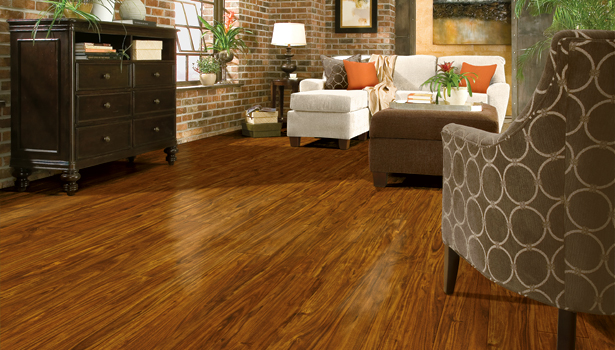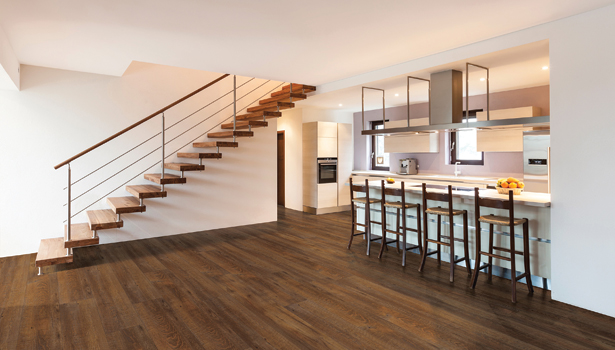Finding Success in Selling LVT














With so many dealers on board in this area, and so many new products and companies entering the category, the question becomes: How can retailers profitably sell LVT in such a competitive market?
First, one must understand how LVT has risen to the top, and some companies say they know why: Because it is a better product with quality performance benefits and realistic visuals, says Amy Tucker, LVT marketing project manager for IVC Group. “LVT [will] outperform the natural ones it imitates at a value price. It has looks you want while performing at a better price. Plus, it’s easier to install, which saves time and money.”
Jimmy Alexander, Metroflor Corp.’s product and brand manager, says there are a couple of reasons as to why the company is finding success with LVT. “Certainly, LVT is red-hot right now and only getting hotter. As the category has grown, so have the number of competitors. Metroflor has been successful because we are an LVT company at our core. Our commitment to LVT dates back to the inception of the category. As a result, decades of experience with LVT have led us to an understanding of how to produce quality products for a great value that meet the needs of our distribution network, flooring dealers and consumers.”
He adds how it is important to remain faithful to innovation, and Metroflor strives to do just that. “From inventing the industry’s first floating LVT in Konecto to becoming the first to offer UniFit from Unilin, Metroflor continually looks for ways to improve on the products it brings to market.”
However, innovation doesn’t always spawn simply from creativity; sometimes it is the only option a business has in order to survive during a messy economy. Yon Hinkle, general manager of residential tile and design, for Armstrong, says, “Tough economic times can require finding new ways to work and new categories to sell.”
But there is something about LVT that has given it the successful advantage over other types of flooring, and Michael Freedman, president of FloorFolio Industries, suggests “the first and most critical reason—which many will never admit—is the costs of LVT continued to decrease while other products maintained or increased their price points.”
This ended up causing cost structure lines to blur between categories, he adds, making LVT an acceptable choice. Simultaneously, costs for LVT began decreasing, but the quality of the product continued to improve.
“It no longer looked plastic, and the true-to-life realistic visuals helped the product to be used in applications it never was considered for in the past,” says Freedman. “[FloorFolio’s LVT] product, for example, is used in upscale apartments and condos where typically real exotic wood would only be used.”
An added bonus that has helped in FloorFolio’s success has been to maintain consistent competitive pricing for years while others charged more for their product, according to Freedman. “We have also insisted that our product be made from pure, virgin, raw materials to ensure a quality product was produced, using premium films that offered clear and crisp visuals.”
Selling to the Consumer
When selling LVT to consumers, there are a number of things the specialty retailer should keep in mind in order to make a successful sale. Hinkle says the first thing is to educate the consumer about the product and how it benefits her. Another tip is to explain the differences between LVT and other flooring options. Perhaps mention the ease of LVT’s installation over subfloor irregularities or the time it takes to install. Finally, mentioning that a product is made in the U.S. is also a positive from a marketing perspective as well as logistics and supply chain angle.
Customers like to know when products are American-made, he adds.
Piet Dossche, president of USFloors, has noticed as the LVT category has become more popular consumers are beginning to become more knowledgeable about it.
So as more people begin to become more aware and prefer LVT, a few tips he suggests regarding how to sell LVT more profitably is first, “to offer the consumer a product with unique features that identifies and provides solutions to real problems—like our COREtec Plus.”
The second tip he recommends trying, not just with LVT but in general, “Never go straight to the lowest price. Sell the features and benefits that add value to better products.”
Mark Hanson, vice president of Novalis, North America, said, “Selling LVT starts with the acceptance of it as a product that can meet the many needs the consumer faces. Items like moisture issues, durability and budget restraints, just to name a few. The ability to show larger samples and display floors to the consumer really brings to light the advances LVT has gone through in styling and designs, giving end users added confidence in their decision.”
He added, “While some hard surfaces offer a warm, rich environment, they are not suitable for every use and lifestyle. With the ease of maintenance and durability of LVT, retailers can offer consumers a product that will give them both the look they want and durability to stand up to active lifestyles.”
Tucker adds, “Another selling tip is to take an LVT sample over to an actual, natural product to show the incredible realism. This allows you to show the consumer she can truly get the look she wants at a better price point.”
Style preferences undoubtedly vary across the U.S., “However, those that we see trending today include wood visuals that contain chatter marks, wire brush, gray tones and tiles with color variation.” Tucker says it’s important to make customers aware of how realistic LVT designs are to appeal to a wide variety of style tastes and demographics.
Some of the top types of LVT Hinkle notices Armstrong customers gravitate toward include travertine and true stone visuals, including terracotta looks in its Alterna line. “Most customers have not seen a vinyl tile that can be grouted before, so LVT has that immediate impact of being new and exciting. Retailers can use this as an advantage when selling and offer LVT to their customers as a better alternative.
“Of course, wood visuals in our Luxe Plank are offered in the most popular colors and species which our customers love,” he points out.
Hanson noted while wood plank patterns continue to maintain the top selling styles in its product line, “we continually see the groutable tile patterns edging closer to the top of our best sellers list. The trends in different wood species and stone patterns are becoming more geographical then ever before and we are always trying to keep up with the demand.”
Helping its retail partners be profitable with LVT by providing the correct product at a good value is vital to customer satisfaction and loyalty, says Alexander. “At Metroflor, we strive to provide the most complete assortment of installation options, sizes and visuals in the industry. By doing so, we can arm retailers with products that meet the needs, tastes and lifestyles of any customer.” He adds the best way to be profitable is to make sure she does not have to leave your store to have her needs met.
Due to the wide range of possible installation methods associated with offering five compatible tile sizes, Hinkle says something Armstrong has done to simplify things for customers is to create a tile selection guide in both hard copy and online that allows dealers to calculate how much of each tile they will need for any given job. “If you’re installing 200 square feet, this guide helps you determine what percent of each size you’ll need. When the collection and possibilities are this large, you have to be clear. The guide also provides inspiration for the phenomenal number of potential layout patterns, including staggered brick, herringbone, windmill and opus patterns.”
He explains Armstrong’s website has been a valuable resource for consumers to learn about the product and a lead-generating machine for dealers. “[Armstrong.com] helps deliver knowledgeable customers to the retailer’s door, helping to close the sale.”
Armstrong’s Alterna LVT is one of the top products sold, Hinkle says, because it is an alternative to natural stone and ceramic tile that is “just as durable and beautiful. It’s warmer to the touch, kinder to your feet and easy to maintain.”
The Engage brand by Metroflor has seen extreme success since its launch nearly three years ago, notes Alexander. “The click LVT category has seen phenomenal growth during this period and Engage has expanded in both sales and product offering to stay ahead of the curve.” Totaling nearly 70 SKUs, Engage covers all the bases with a true “good, better, best” story built on varying gauges, wear layers, sizes and locking mechanisms.
IVC is introducing many ways to help retail customers be successful selling LVT, including building a state-of-the-art plant in Dalton to provide a domestic source. Tucker says the company has also spent a significant amount of time and effort to research current trends in order to provide products customers want with visuals and product performance, and finally training. “Offering opportunities for product training is key to helping retailers be more successful in this rapidly growing product category.”
Having many options can sound overwhelming, but offering a bigger variety has contributed to FloorFolio’s success in LVT. Freedman notes FloorFolio has been founded on the principle of offering customers more choices. “We offer thousands of patterns and styles. We don’t like to limit ourselves to two or three best sellers. In our standard sample collection we have so many collections that offer and meet different niches, it’s hard to break down which is our best one.”
Choice, he stresses, is what makes companies like FloorFolio successful.
To plainly answer our initial question, when customers are armed with enough knowledge of a product, as well as a variety of options to cater to each individual need, it allows for a much more confident decision making, and consequently more successful outcomes when selling luxury vinyl.
Looking for a reprint of this article?
From high-res PDFs to custom plaques, order your copy today!















